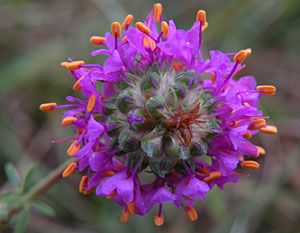Compact Prairie Clover

© Don Verser
Dalea compacta
Family: Fabaceae (Legume Family)
Compact Prairie Clover (Dalea compacta) is a drought-tolerant, nitrogen-fixing native perennial known for its dense spikes of pink to lavender flowers and fine-textured foliage. This clover is native to prairies and dry, open habitats across the south-central United States, including parts of Texas. Its compact form and attractive blooms make it ideal for native plant gardens, wildflower meadows, and restoration projects.
- Scientific Name: Dalea compacta
- Common Names: Compact Prairie Clover
- Family: Fabaceae (Legume Family)
- Growth Habit: Upright, clump-forming perennial
- Height: 12 to 18 inches
- Leaves: Pinnately compound, with small, narrow leaflets; soft texture
- Flowers: Dense, rounded spikes of purple-pink flowers with yellow stamens
- Bloom Time: Summer
- Wildlife Benefits: Attracts bees and other pollinators; fixes nitrogen in soil
Habitat & Range in Southeast Texas
Compact Prairie Clover is found in:
- Dry Prairies & Grasslands: Prefers open, sunny areas with minimal competition
- Sandy or Rocky Soils: Tolerates nutrient-poor conditions
- Restored Native Meadows: A valuable component of prairie restoration efforts
This species is well-suited to dry, well-drained soils and performs well in harsh, sunny environments.
Ecological Importance
- Pollinator Support: Provides nectar and pollen for native bees
- Soil Health: As a legume, it enriches the soil by fixing nitrogen
- Low Maintenance: Thrives in low-water landscapes and requires little care
Landscaping & Gardening Uses
Compact Prairie Clover is perfect for sustainable landscapes and native plantings:
- Wildflower Meadows: Adds texture and color to mixed prairie gardens
- Pollinator Gardens: Essential nectar source for bees and beneficial insects
- Erosion Control: Deep root system helps stabilize soil
Planting & Care
- Sunlight: Full sun
- Soil: Well-drained; tolerates sandy, rocky, or poor soils
- Water Needs: Low; drought-tolerant once established
- Maintenance: Minimal; cut back in late winter if desired
- Companion Plants: Mixes well with Little Bluestem (Schizachyrium scoparium), Texas Bluebonnet (Lupinus texensis), and Indian Blanket (Gaillardia pulchella)
Fun Facts
- Compact Prairie Clover is a member of the pea family and produces pods after flowering.
- Its deep roots make it especially suited for dry and degraded landscapes.
- The flowers form in tight, globe-like heads that stand out in prairie settings.
Conservation & Native Plant Advocacy
Incorporating Compact Prairie Clover into your landscape helps conserve native biodiversity and supports healthy soils. Its role as a nitrogen-fixer makes it a valuable ally in restoration and sustainable gardening practices.
Where to Find It
-
Interested in adding Compact Prairie Clover to your garden? Check if this is in stock or add to cart to purchase directly from our Natives Nursery.


